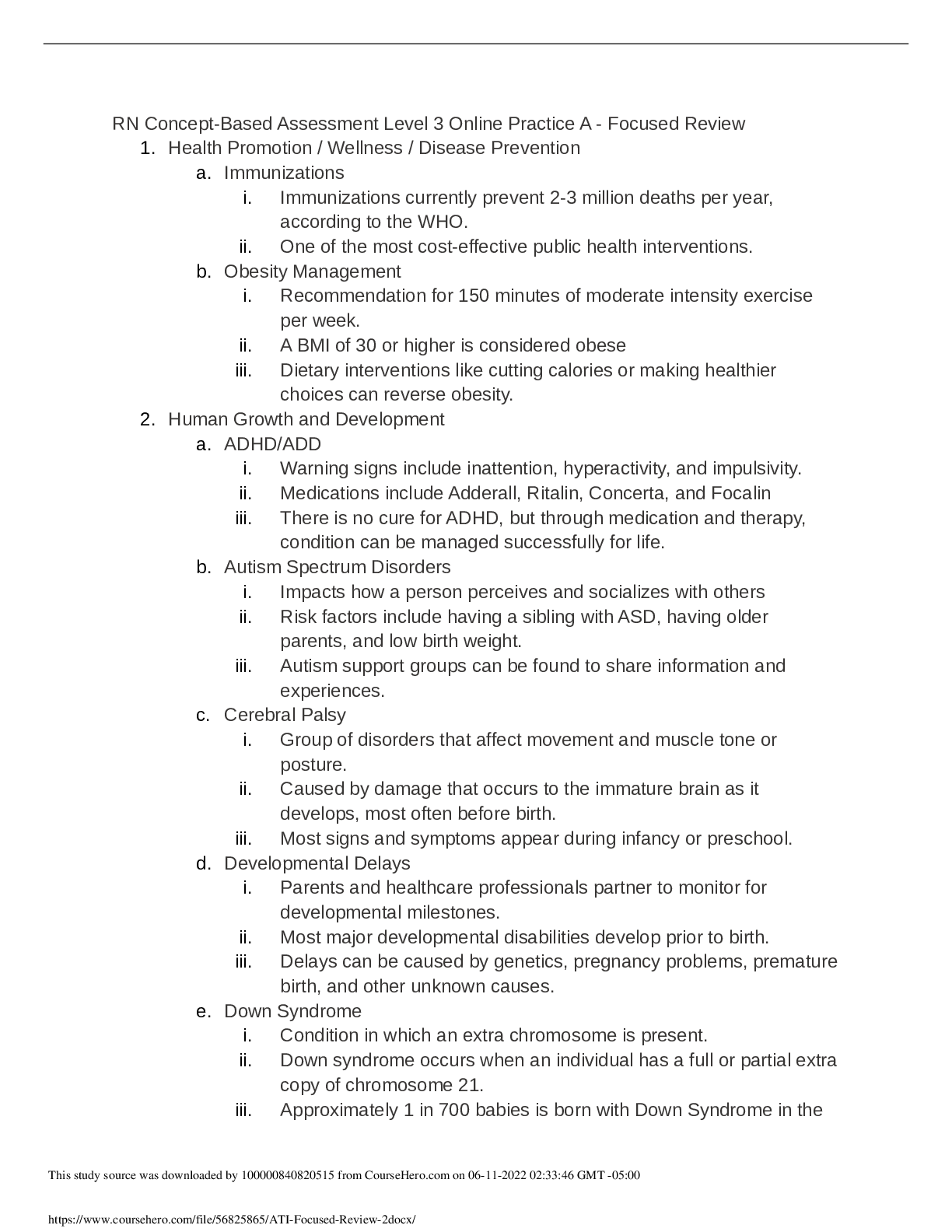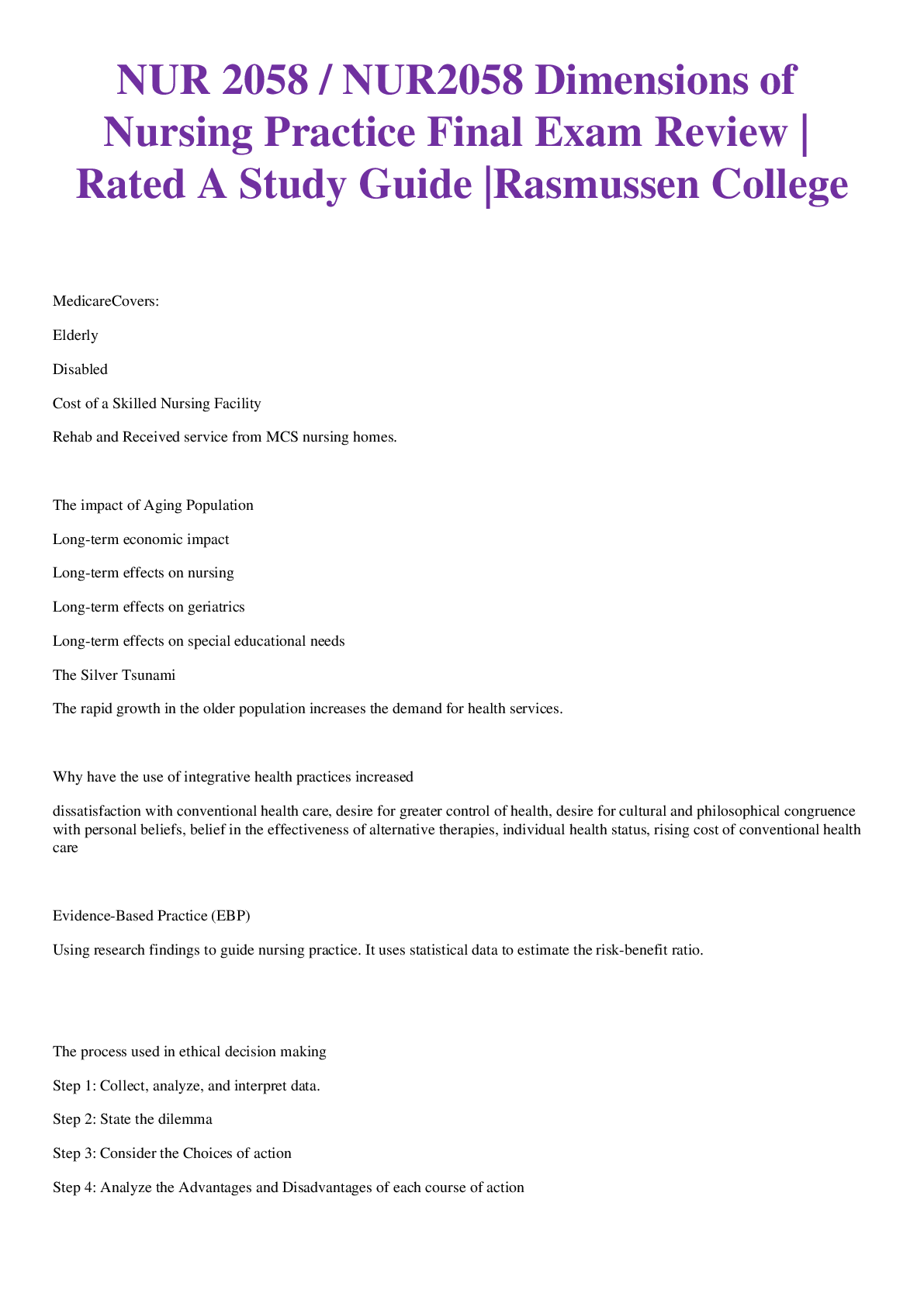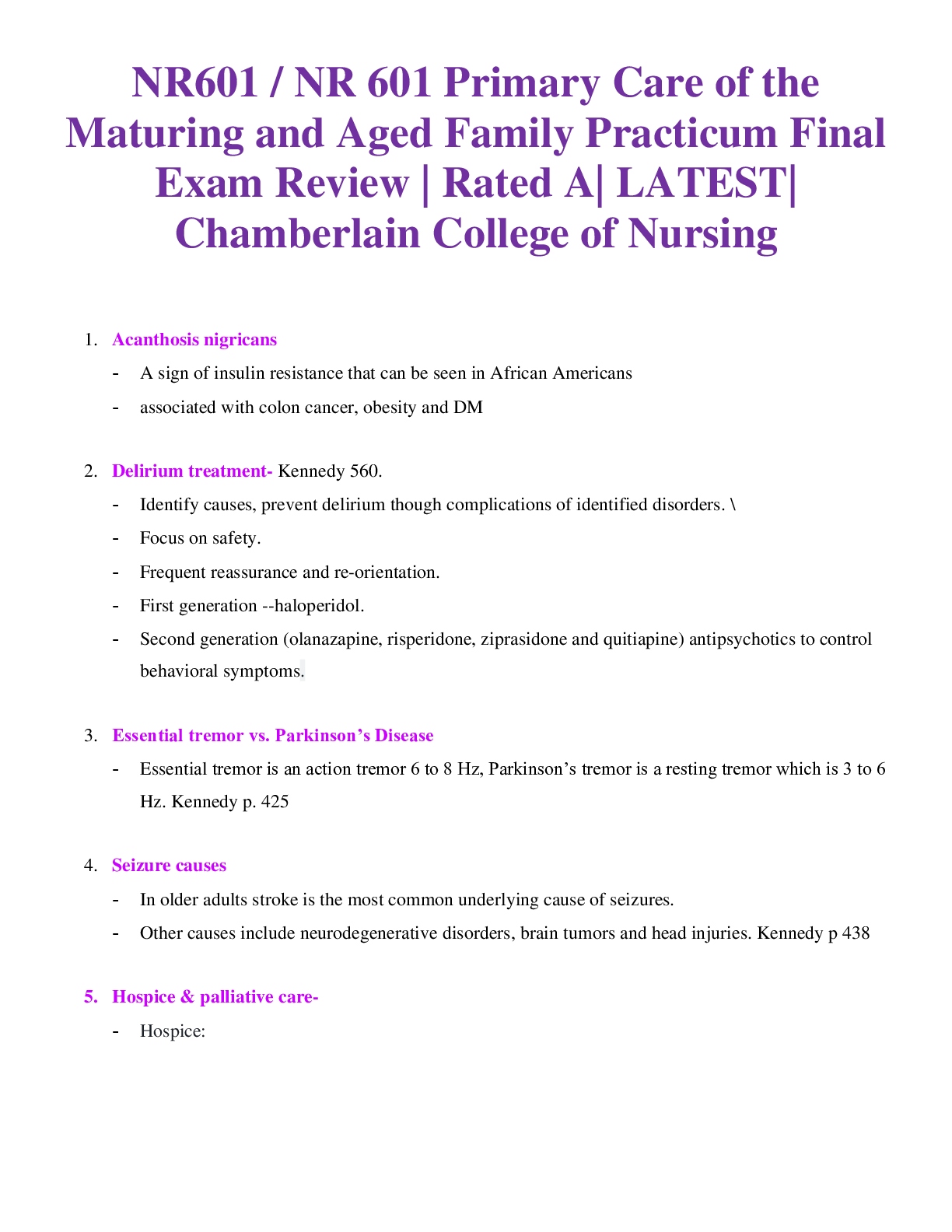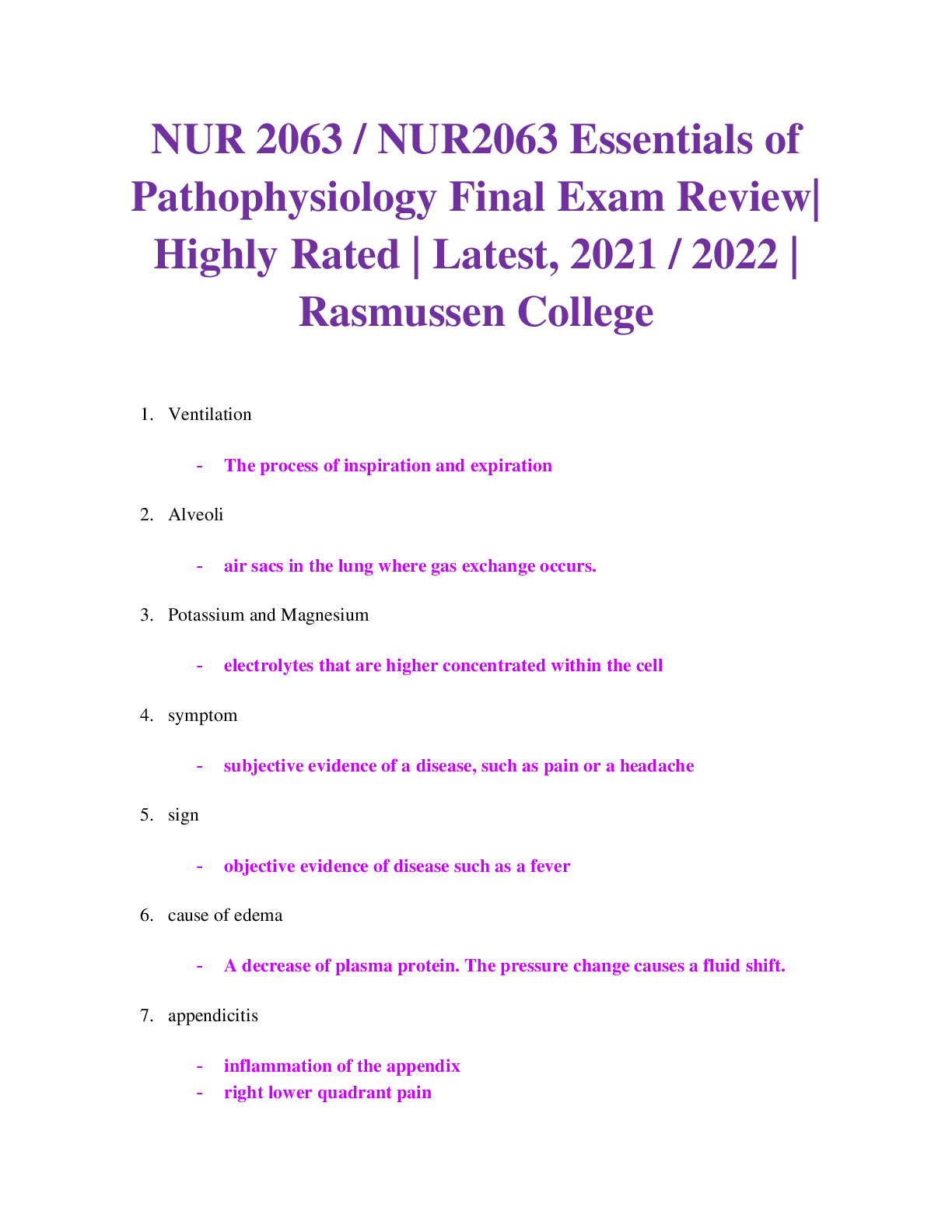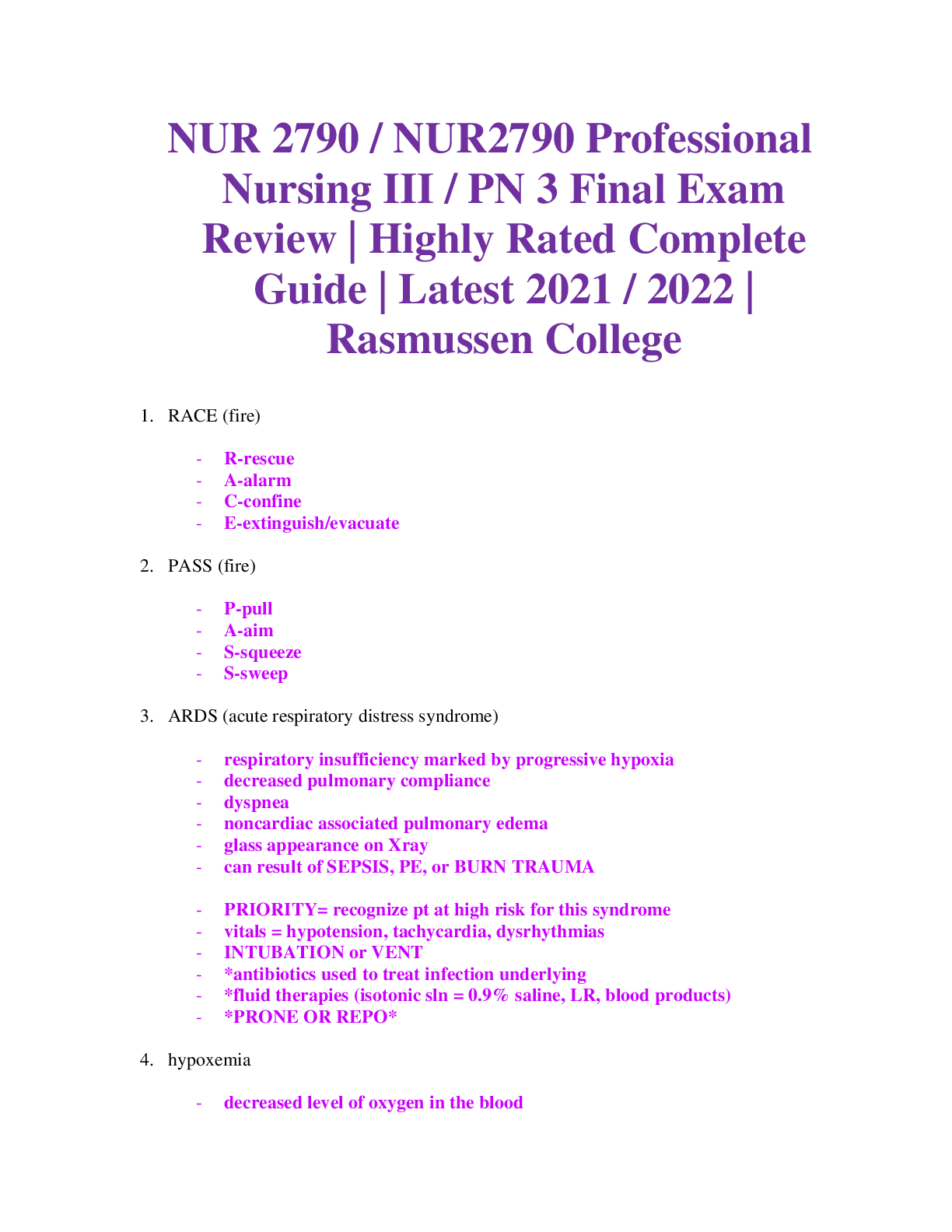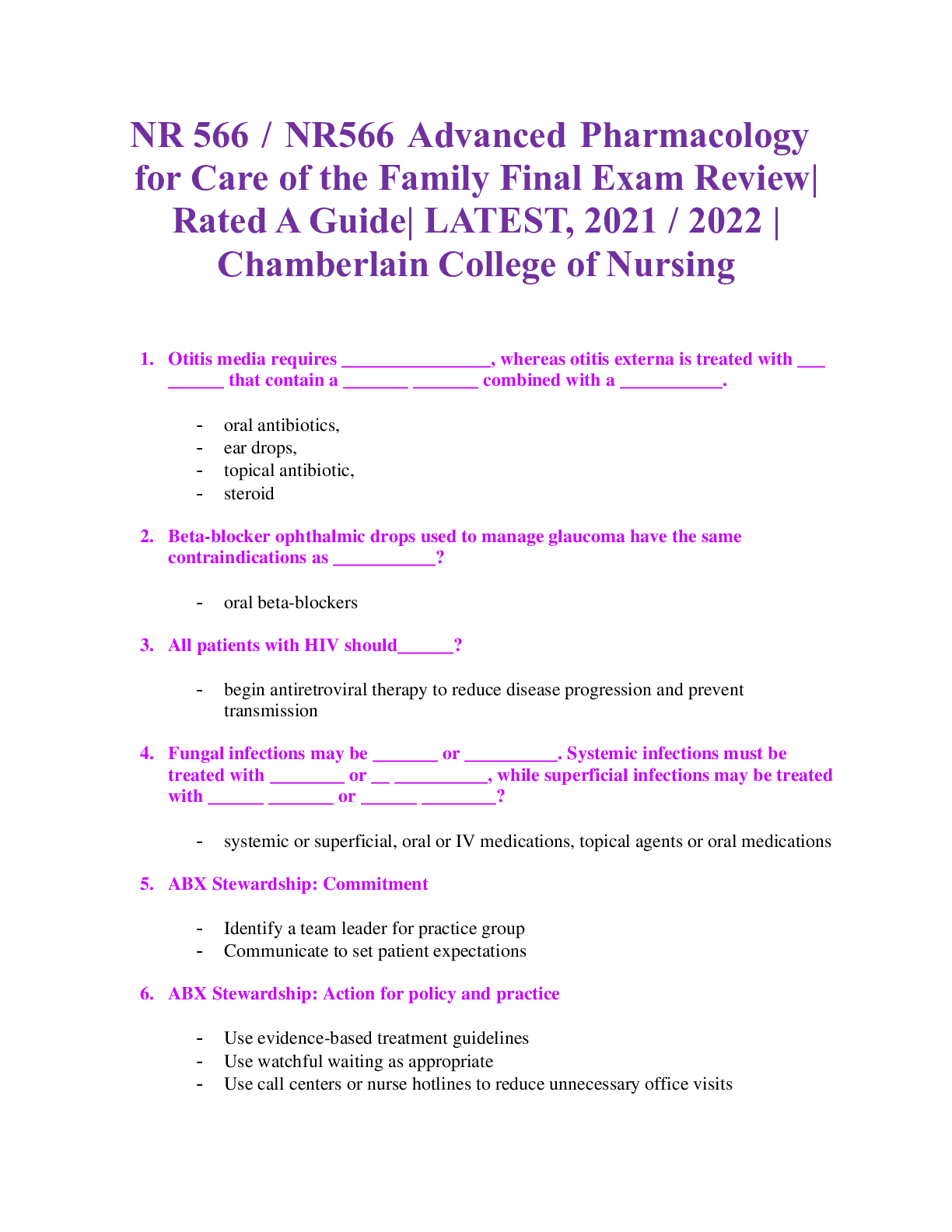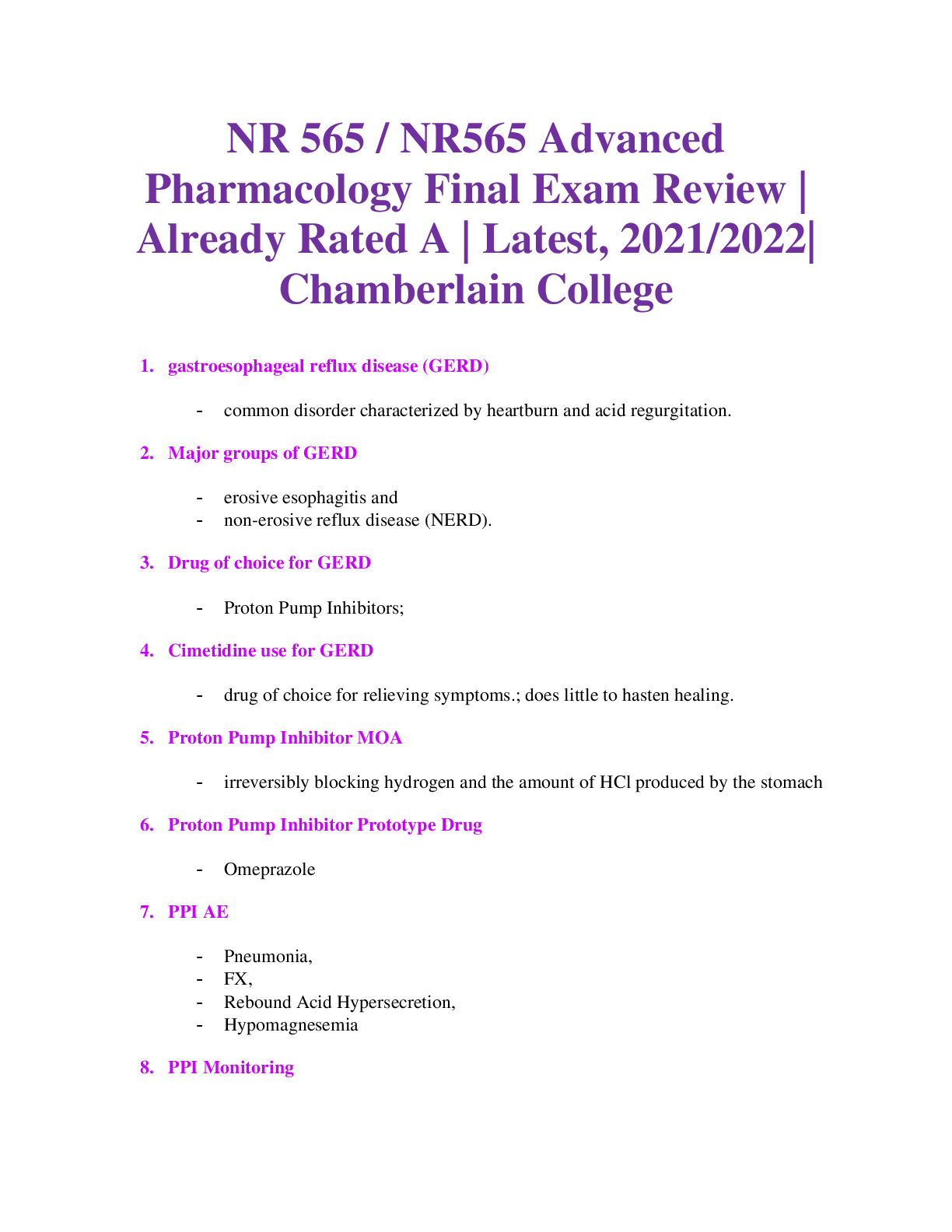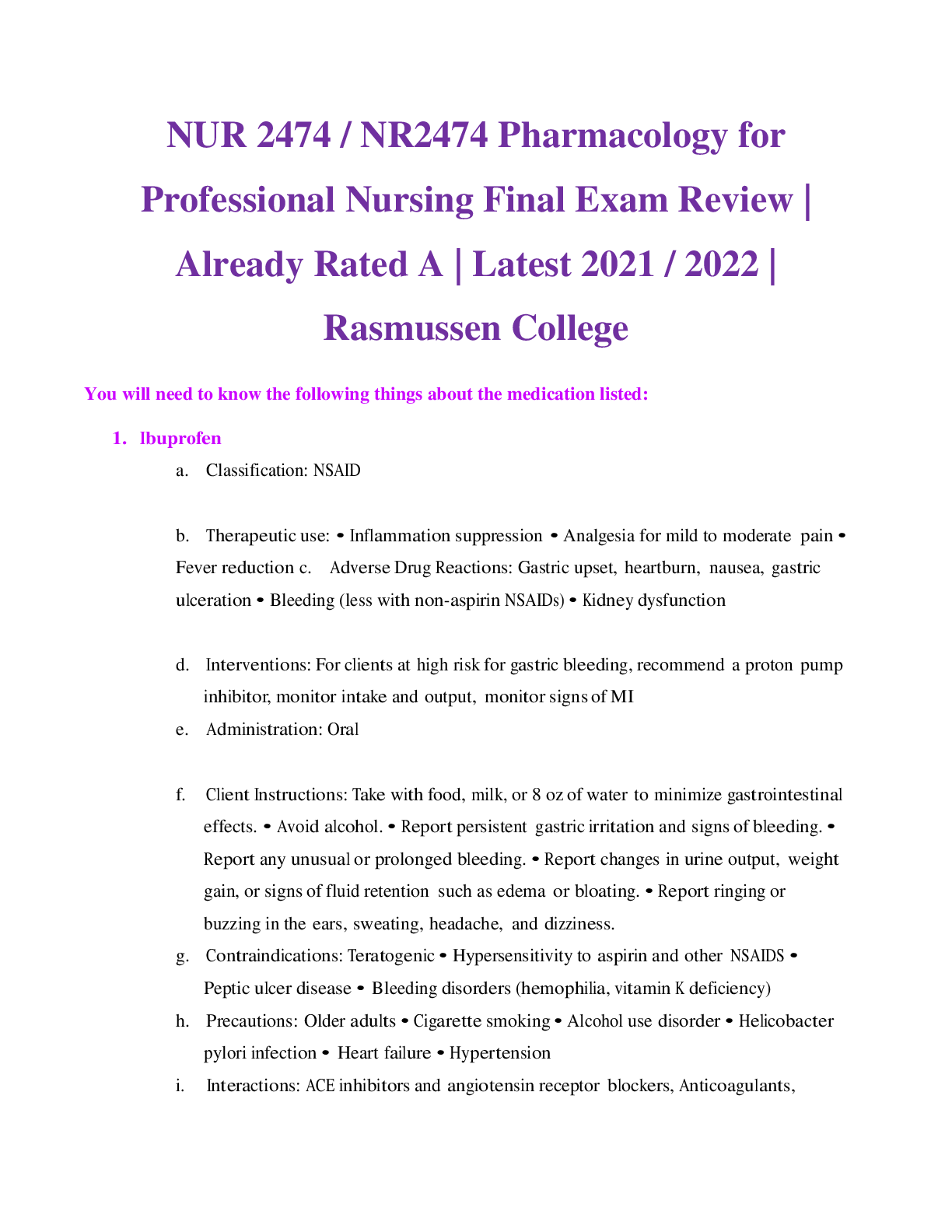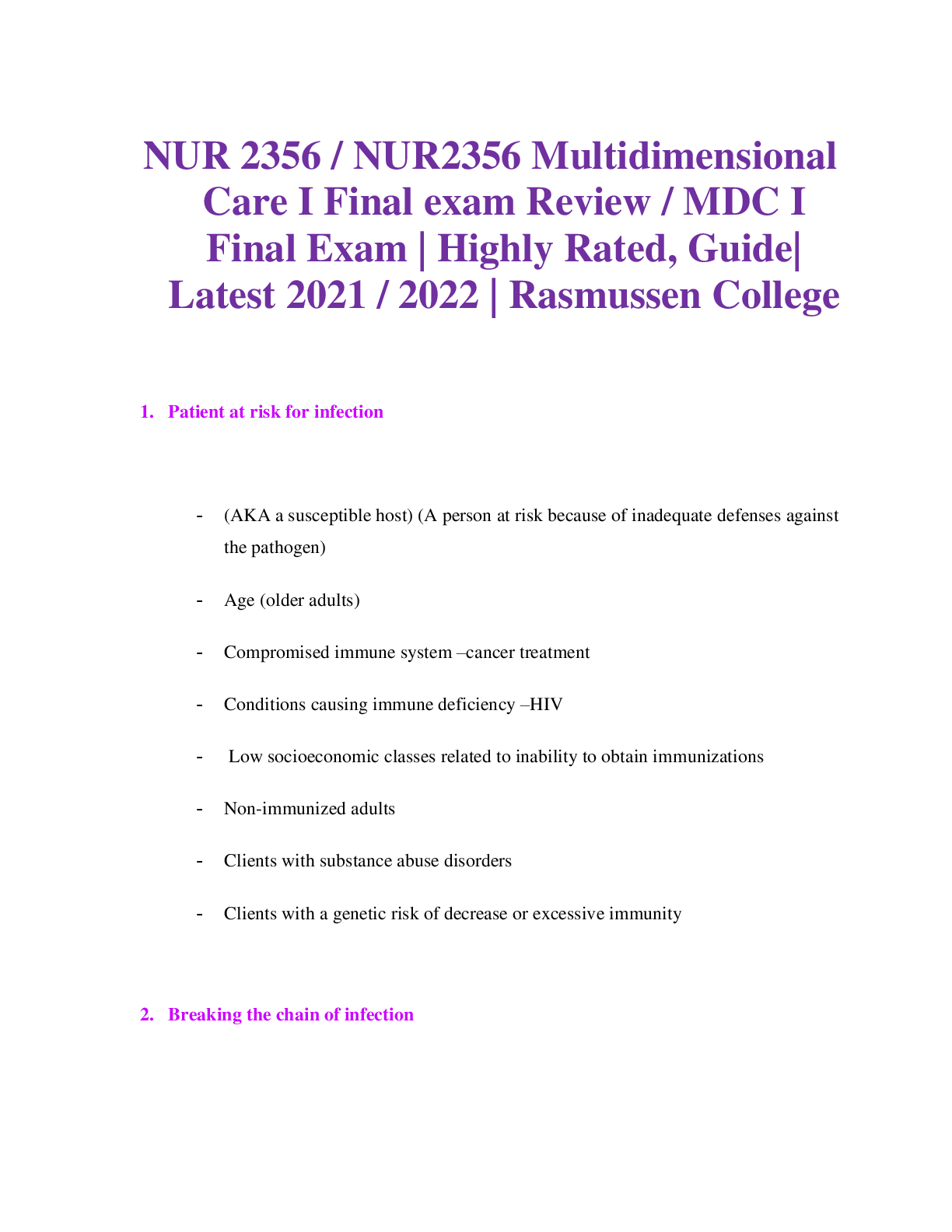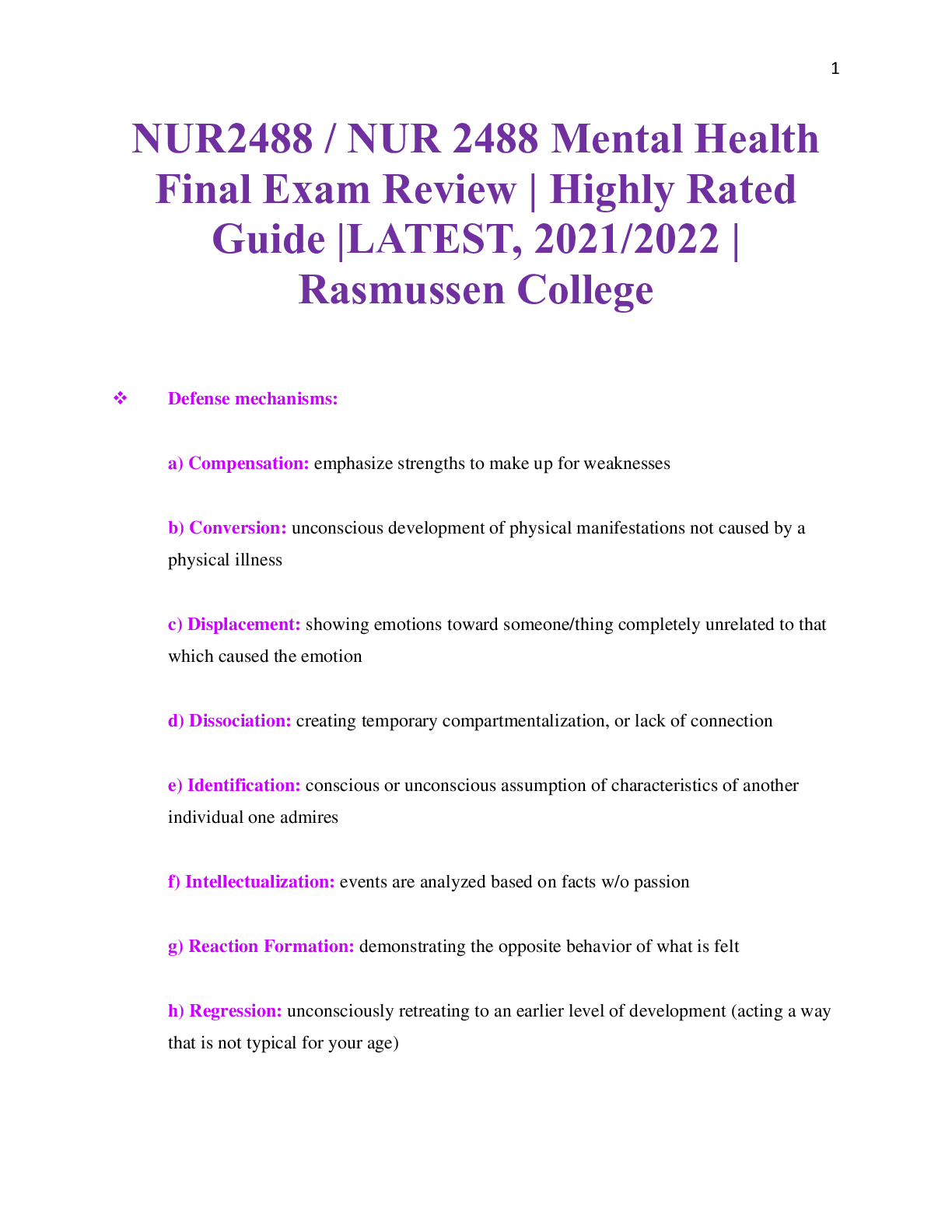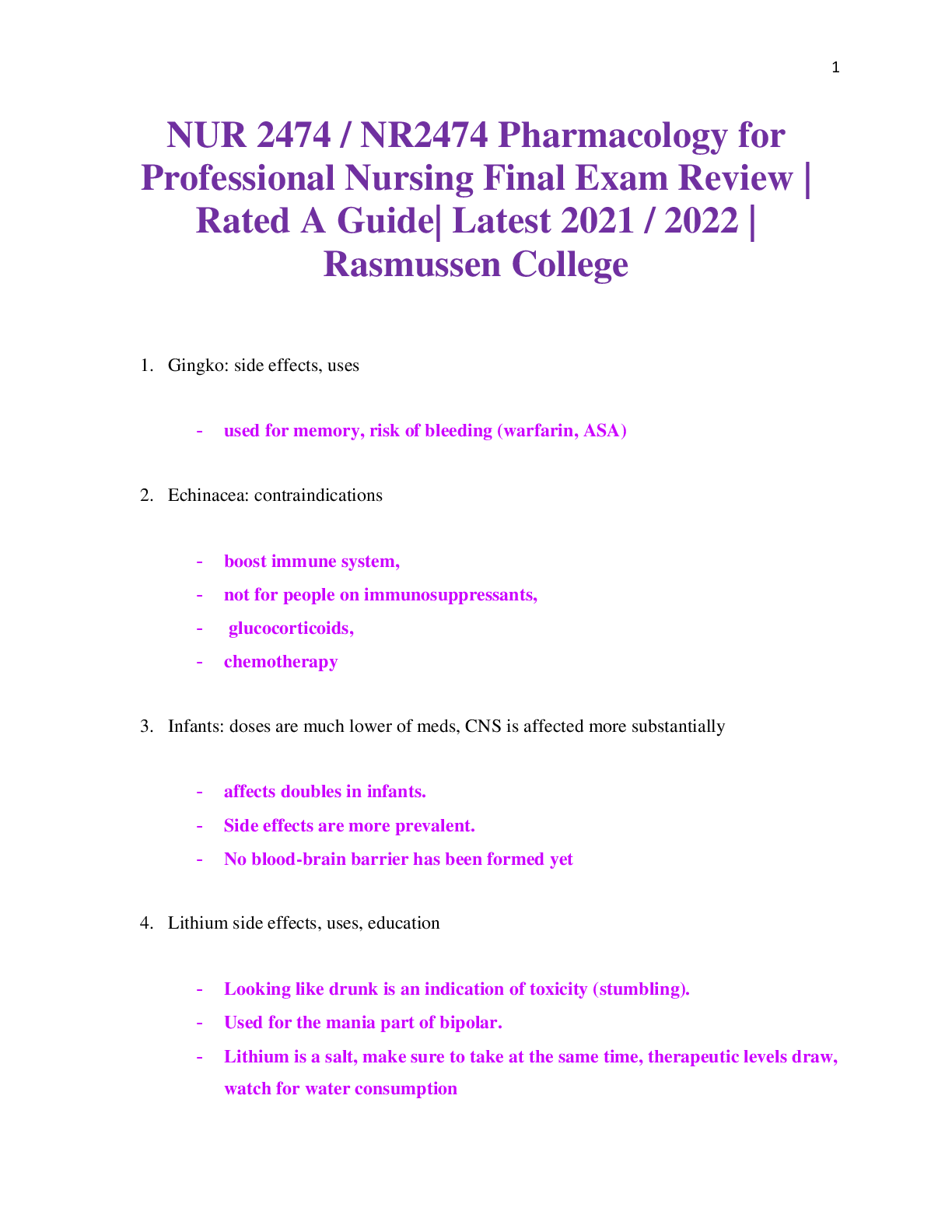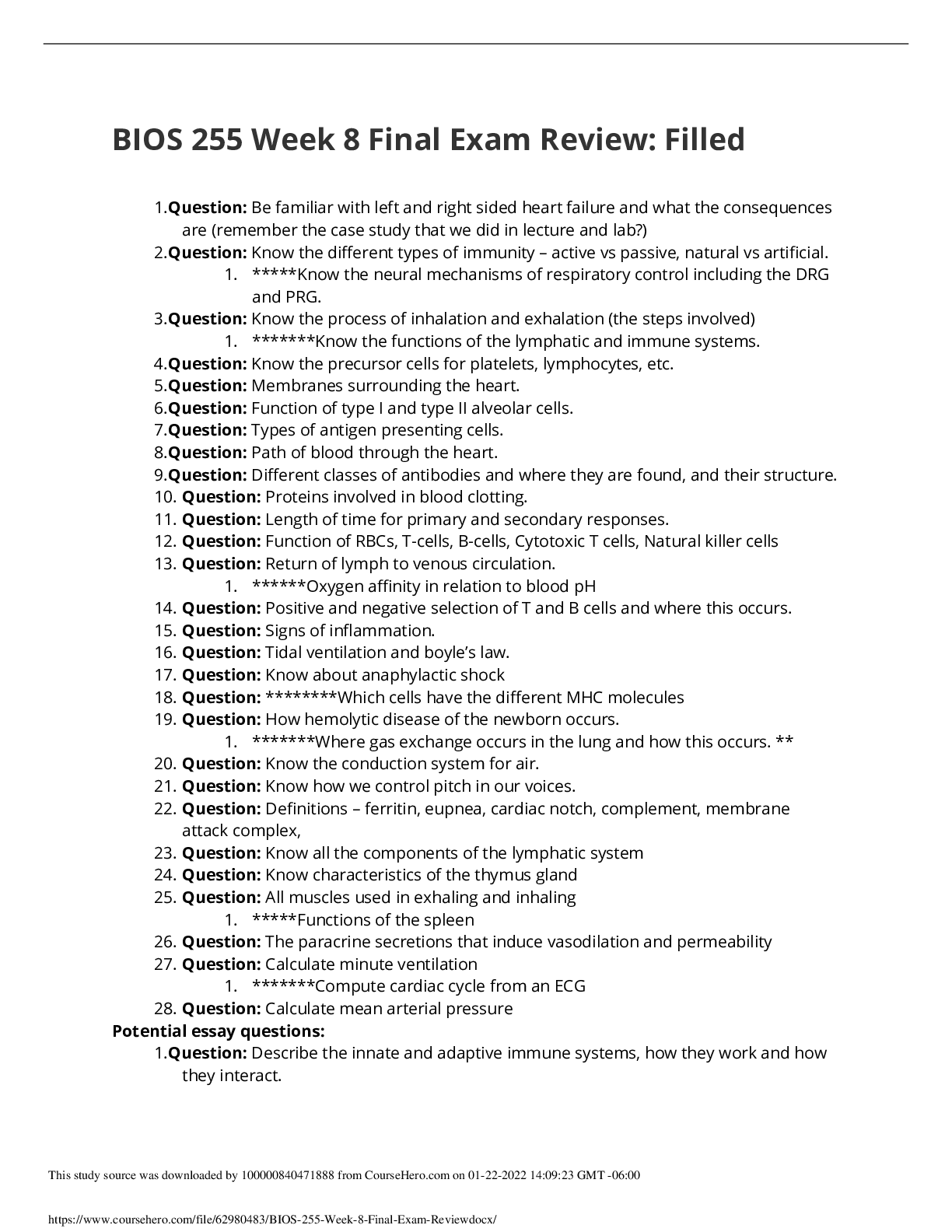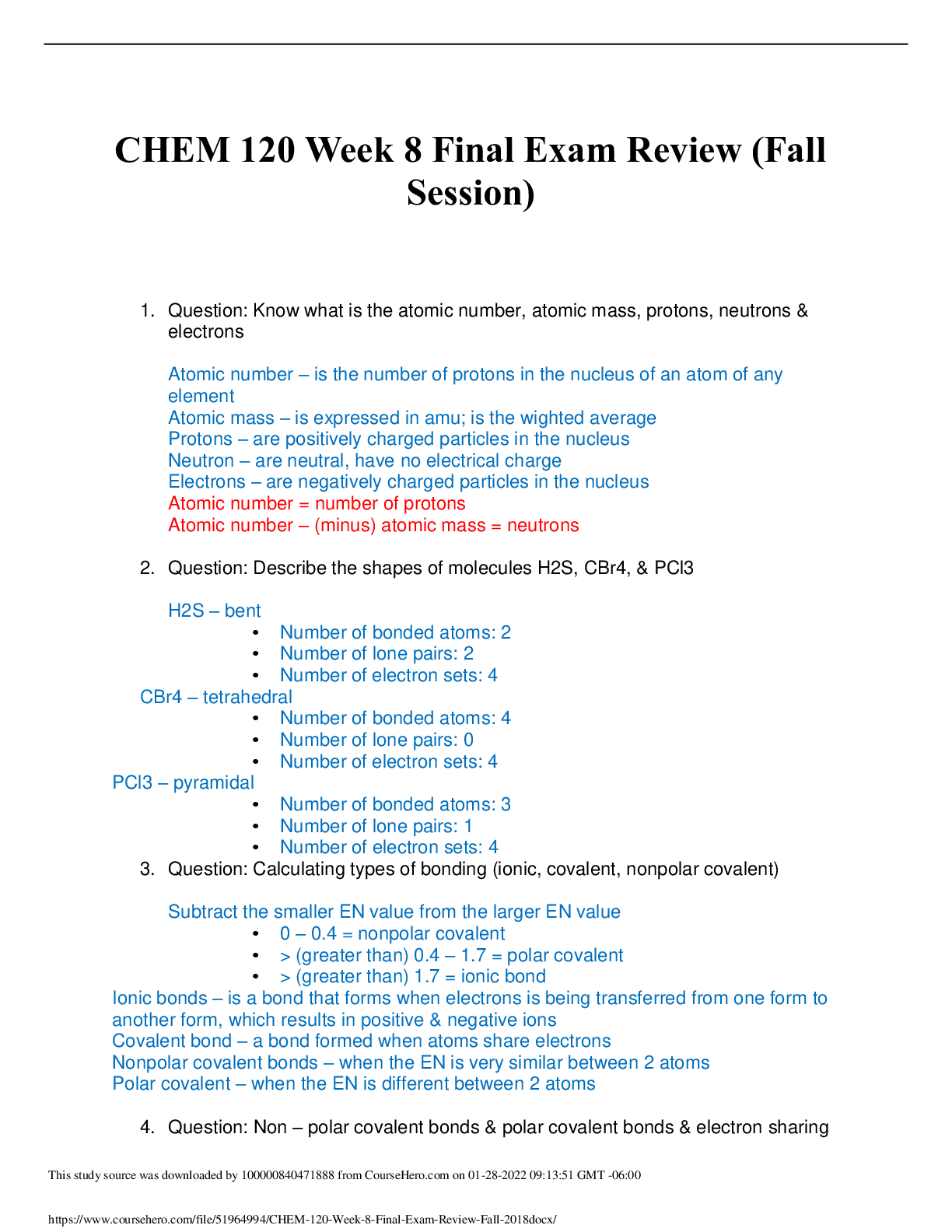Anatomy > EXAM REVIEW > Bios 255 Final exam review with well explained Rationales | 100% Guarnteed (All)
Bios 255 Final exam review with well explained Rationales | 100% Guarnteed
Document Content and Description Below
Bios 255 Final exam review Be familiar with left and right sided heart failure and what the consequences are (remember the case study that we did in lecture and lab?) (698) Left side: One cause of m... itral insufficiency, in which there is backflow of blood from the left ventricle into the left atrium, is mitral valve prolapse (MVP). In MVP one or both cusps of the mitral valve protrude into the left atrium during ventricular contraction. Mitral valve prolapse is one of the most common valvular disorders, affecting as much as 30% of the population. It is more prevalent in women than in men, and does not always pose a serious threat. The left side of the heart receives blood rich in oxygen from the lungs and pumps it to the remainder of the body. As the ability to pump blood forward from the left side of the heart is decreased, the remainder of the body does not receive enough oxygen especially when exercising. This results in fatigue. In addition, the pressure in the veins of the lung increases, which may cause fluid accumulation in the lung. This results in shortness of breath and pulmonary edema. Right side: In aortic stenosis the aortic valve is narrowed, and in aortic insufficiency there is backflow of blood from the aorta into the left ventricle. In right-sided heart failure, the right ventricle loses its pumping function, and blood may back up into other areas of the body, producing congestion. Congestion affects the liver, the gastrointestinal tract, and the limbs. In addition, the right ventricle may be unable to pump blood efficiently to the lungs and to the left ventricle. Causes of right-sided heart failure include left-sided heart failure and lung diseases such as chronic bronchitis and emphysema. Other causes include congenital heart disease, clots in pulmonary arteries, pulmonary hypertension, and heart valve disease. Know the different types of immunity – active vs passive, natural vs artificial. First, let us define the following terms and then we can put them together. The term active generally means that your body is producing antibodies by exposure. Passive is a term where the antibodies are being transferred to you, i.e. breast milk IgA to infant. Natural terms the introduction of the antigen via exposure. Artificial is the introduction of antigens/antibodies via an altered state of the microbe/ antibody. Naturally Acquired Active Immunity- Following exposure to a microbe, antigen recognition by B cells and T cells and costimulation lead to formation of antibody-secreting plasma cells, cytotoxic T cells, and B and T memory cells. Naturally Acquired Passive Immunity- IgG antibodies are transferred from mother to fetus across placenta, or IgA antibodies are transferred from mother to baby in milk during breastfeeding. Artificially Acquired Active Immunity- Antigens introduced during vaccination stimulate cell-mediated and antibody-mediated immune responses, leading to production of memory cells. Antigens are pretreated to be immunogenic but not pathogenic (they will trigger an immune response but not cause significant illness.) Artificially Acquired Passive Immunity- Intravenous injection of immunoglobulins. *****Know the neural mechanisms of respiratory control including the DRG and PRG. (872) Respiratory center- Neurons in the pons and medulla oblongata of the brain stem that regulate breathing. It is divided into the medullary respiratory center and the pontine respiratory center. Within the medullary respiratory center, you find two respiratory groups, the ventral respiratory group (AKA expiratory area) and the dorsal respiratory group (AKA inspiratory area). The DRG generates impulses to the diaphragm via the phrenic nerves and the external intercostals via the intercostal nerves. These impulses trigger contraction of these muscles which in turn execute inhalation. When the nerves are not firing, this passive relaxation allows recoil of the lungs and thoracic wall, passive exhalation. The VRG is only activated during forceful inhalation and trigger the accessory muscles to work. An important part of the VRG is the Pre-Botzinger Complex which is believed to be important in the generation of the rhythm of breathing (Pacemaker cells) . PRG (Pontine Respiratory Group)- A collection of neurons in the pons that transmits nerve impulses to the dorsal respiratory group, and may modify the basic rhythm of breathing. (AKA pneumotaxic area) The PRG may play a role in both inhalation and exhalation by modifying the basic rhythm of breathing generated by the VRG, as when exercising, speaking, or sleeping. Know the process of inhalation and exhalation (the steps involved) (FIG. 24.13) During Inhalation, the diaphragm contracts and the external intercostals contract. The chest cavity expands, and the alveolar pressure drops below atmospheric pressure. Air flows into the lungs in response to the pressure gradient and the lung volume expands. During deep inhalation, the scalene and sternocleidomastoid muscles expand the chest further, thereby creating a greater drop in alveolar pressure. During exhalation, the diaphragm relaxes and the external intercostals relax. The chest and lungs recoil, the chest cavity retracts, and the alveolar pressure increases above atmospheric pressure. Air flows out of the lungs in response to the pressure gradient, and the lung volume decreases. During forced exhalations, the internal intercostals and the abdominal muscles contract, thereby reducing the size of the chest cavity further and creating a greater increase in alveolar pressure. Inhalation: • Diaphragm: contracts & moves down • Intercostal muscles: contract, move ribs out • Chest volume: increases • Pressure in lungs: decreases • Air Flow: higher percentage of oxygen Exhalation: • Diaphragm: relaxes & moves up • Intercostals muscles: relax, move ribs in. • Chest volume: lessens • Pressure in lungs: increases • Air flow: carbon dioxide out *******Know the functions of the lymphatic and immune systems. *****The primary functions of the lymphatic is system is to 1. Drain excess interstitial fluid, 2. Transport dietary lipids and lipid-soluble vitamins, and 3. Carry out immune response. Know the precursor cells for platelets, lymphocytes, etc. The precursor cells for platelets are megakaryocytes. Membranes surrounding the heart. (690) The pericardium surrounds and protects the heart. Covers the heart muscle. The pericardium consists of two main parts: (1) the fibrous pericardium (tough, inelastic, dense irregular connective tissue) -- prevents overstretching of the heart, provides protection, and anchors the heart in the mediastinum. and (2) the serous pericardium (double membrane of outer parietal layer and inner visceral layer, fluid-lubricating part between these layers, reduces friction as the heart moves.) (Walls of heart= 3= epicardium, myocardium, endocardium) Function of type I and type II alveolar cells. (854) The alveolar epithelium comprises two main cell types: the alveolar type I and alveolar type II cell. The type I cell: simple squamous epithelial cells that form a nearly continuous lining of the alveolar wall; main site of gas exchanges, The type II cell, also called septal cells, are fewer in number and are found between type I alveolar cells; rounded or cuboidal epithelial cells with free surfaces containing microvilli, secrete alveolar fluid, which keeps the surface between the cells and the air moist. Type II cells act as the "caretaker" of the alveolar compartment. It responds to damage of the vulnerable type I cell by dividing and acting as a progenitor cell for both type I and type II cells. In addition, it syntheses, stores and releases pulmonary surfactant into the alveolar hypophase, where it acts to optimize conditions for gas exchange. Types of antigen presenting cells. (Table 22.5) Macrophage- Processing and presentation of foreign antigens to T cells, secretion of interleukin-1, which stimulates secretion of interleukin-2 by helper T cells and induces proliferation of B cells; secretion of interferons that stimulate T cell growth. Dendritic Cells- Processes and presents antigens to T cells and B cells; Found in mucous membranes, skin, and lymph nodes. B cell- Processes and presents antigen to helper T cells. Path of blood through the heart. A drop of blood enters the heart via the Vena Cava (Superior or inferior) or coronary sinus into the Right Atrium. From the right atria, it flows into the Right ventricle. The right ventricle pumps the blood into the pulmonary trunk where is branches into the left and right pulmonary arteries. The blood then returns from the lungs via the pulmonary veins into the left atrium. It then leaves the left atria and goes into the left ventricle where the blood is returned to the outlying tissues via the aorta. Different classes of antibodies and where they are found, and their structure. IgG- Most abundant (80% of antibodies in blood). Found in the blood, lymph and intestines. Monomer. Protects against bacteria and viruses by enhancing phagocytosis, neutralizing toxins, and triggering complement system. The ONLY antibody that will cross placenta. IgA- Found in sweat, tears, saliva, mucus, breast milk, and gastrointestinal secretions. 10-15% of antibodies in blood. Occurs as monomer and dimers. Decreases during stress. LOCALIZED protection of mucous membranes against bacteria and viruses. IgM- Found in blood and lymph (10-15% of antibodies in blood). Pentamer. FIRST to be secreted by plasma cells after initial exposure to any antigen. Activates complement and causes agglutination and lysis. Also present as monomer n surfaces of B cells, where they serve as antigen receptors. In blood plasma, anti-A and anti-B antibodies of ABO blood group, which bind to A and B antigens during incompatible blood transfusions. IgD- Found on surfaces of B cells as antigen receptors. Monomer. Activates B cells. 0.2% of antibodies in blood. IgE- Found on mast cells and basophils. Involved in allergic and hypersensitivity reactions and protects against parasitic worms. Monomer. Less than 0.1% of antibodies in blood. Proteins involved in blood clotting. (677) Two pathways, called the extrinsic pathway and the intrinsic pathway, lead to the formation of prothrombinase. Once prothrombinase is formed, the steps involved in the next two stages of clotting are the same for both the extrinsic and intrinsic pathways, and together these two stages are referred to as the common pathway. Prothrombinase converts prothrombin (a plasma protein formed by the liver) into the enzyme thrombin. Thrombin converts soluble fibrinogen (another plasma protein formed by the liver) into insoluble fibrin. Fibrin forms the threads of the clot. Length of time for primary and secondary responses. (828) Immune responses, whether cell-mediated or antibody-mediated, are much quicker and more intense after a second or subsequent exposure to an antigen than after the first exposure. Initially, only a few cells have the correct specificity to respond, and the immune response may take several days to build to maximum intensity. Because thousands of memory cells exist after an initial encounter with an antigen, the next time the same antigen appears they can proliferate and differentiate into helper T cells, cytotoxic T cells, or plasma cells within hours. After an initial contact with an antigen, no antibodies are present for a period of several days. Then, a slow rise in the antibody titer occurs, first IgM and then IgG, followed by a gradual decline in antibody titer. This is the primary response. Memory cells may remain for decades. Every new encounter with the same antigen results in a rapid proliferation of memory cells. After subsequent encounters, the antibody titer is far greater than during a primary response and consists mainly of IgG antibodies. This accelerated, more intense response is called the secondary response. Antibodies produced during a secondary response have an even higher affinity for the antigen than those produced during a primary response, and thus they are more successful in disposing of it. Function of RBCs, T-cells, B-cells, Cytotoxic T cells, Natural killer cells RBCs: Transport oxygen bound to hemoglobin molecules; also transport small amount of carbon dioxide T-cells: -Plays a central role in adaptive immune response,-Activate both humoral and cellular arms,-Once primed by APC presentation of antigens, they help activate T and B cells, induce T and B cell proliferation, their cytokines recruit other immune cells ,-Amplifies the immune response of the innate immune system, -Activate macrophages (more potent killers), -Mobilize lymphocytes and macrophages, and attract other types of WBCs B-cells: Differentiates into antibody-secreting plasma cells when stimulated by antigen Cytotoxic T cells: Check IDs via class 1 MHC on host cells -Will NOT attack a 'healthy self' cell -WILL attack an 'unhealthy self' cell: infected, damaged, old, etc. -WILL attack a "non-self" cell: most any cell from someone else - common transplants/grafts: kidney, liver, heart, lung, skin Natural killer cells: Attacks any intracellular foreign microorganisms; not antigen-specific Return of lymph to venous circulation. Lymph is circulated in a very specialized one-way system. Like the circulatory system the lymph system is made up of vessels and capillaries and have very similar functions. The lymph system is made up of trunks, which are the primary vessels. The trunks will connect and dump into one of two ducts that return lymph to the circulatory system. The Thoracic duct drains lymph from the left half of the cranium, thoracic area, and arm, along with the lymph from the waist down, lower extremities. The Right lymphatic duct drains lymph from the right half of the cranium, thoracic area, and arm. ******Oxygen affinity in relation to blood pH Oxygen affinity essentially is the tightness hemoglobin binds with oxygen. As acidity increases (pH decreases), the affinity of hemoglobin for oxygen decreases, and oxygen dissociates more readily from hemoglobin. BOHR EFFECT- An increase in hydrogen in blood causes oxygen to unload from hemoglobin, and the binding of oxygen to hemoglobin causes unloading of hydrogen from hemoglobin. Hemoglobin can act as a buffer for hydrogen ions. Positive and negative selection of T and B cells and where this occurs. In the thymus. This is where T cells mature and must recognize itself (self-recognition-positive selection), it recognizes its MHC 1 cells. Then it goes and gets measured on its ability to recognize its own antigens, if it does it goes to death or anergy (inactivate). This is negative selection. We do not want an autoimmune disease. If it doesn’t recognize its own antigens, then it passes the negative selection and it survives and can recognize self-MHC proteins but not self-peptides. T cells still need a costimulation to be activated to proliferate and differentiate. If not, they will go through anergy or die. In the red bone marrow: B cells recognize self MHC molecule or other self-antigens, then it will die. If it does not (negative selection), it will become a mature B cell, and it will go out into lymph nodes. Once a immunoglobin and receptor encounter an antigen and receive costimulation, then they will proliferate and differentiate. If they do not get costimulation, they will die or anergy. Signs of inflammation. (812) The four characteristic signs and symptoms of inflammation are redness, pain, heat, and swelling. Inflammation can also cause a loss of function in the injured area (for example, the inability to detect sensations), depending on the site and extent of the injury. Inflammation is an attempt to dispose of microbes, toxins, or foreign material at the site of injury, to prevent their spread to other tissues, and to prepare the site for tissue repair in an attempt to restore tissue homeostasis. Tidal ventilation and boyle’s law. (862) The volume of one breath is called the tidal volume (VT). It is the action of the diaphragm relaxing, the muscle is compressed upward which reduces the volume of the thoracic cavity increasing the pressure within the newly compressed space and creating a pump that forces air molecules from the lungs to travel up the bronchioles, into the bronchi, trachea, larynx and pharynx and exit the body through the nasal passages or the mouth. When the diaphragm contracts it pulls downward toward the abdominal cavity and expands the volume of the thoracic cavity. This in turns decreases the pressure in the lungs and creates empty space which forms a vacuum. This reduction in pressure pulls air into the lungs. That air can enter the respiratory tract from your nasal cavities or your opened mouth, into the pharynx, larynx, trachea, bronchi, bronchioles and into the alveoli to diffuse oxygen and carbon dioxide. It is the inverse relationship of Pressure and Volume of Boyle's Law that creates the pump - vacuum activity that allows for us to breathe. Know about anaphylactic shock (834) Type I (anaphylactic) reactions are the most common and occur within a few minutes after a person sensitized to an allergen is re-exposed to it. A person may experience inflammatory responses, difficulty in breathing through the constricted airways, and a runny nose from excess mucus secretion. In anaphylactic shock, which may occur in a susceptible individual who has just received a triggering drug or been stung by a wasp, wheezing and shortness of breath as airways constrict are usually accompanied by shock due to vasodilation and fluid loss from blood. This life-threatening emergency is usually treated by injecting epinephrine to dilate the airways and strengthen the heartbeat. ********Which cells have the different MHC molecules (817) MHC (Major Histocompatibility Complex) Antigens- Surface proteins on white blood cells and other nucleated cells that are unique for each person (except identical siblings); used to type tissues and help prevent rejection of transplanted tissues. AKA Human Leukocyte Antigens (HLA). Two types, class I and class II. Class I MHC (MHC-I) molecules are built into the plasma membranes of all body cells except RBC’s. Class II MHC (MHC-II) molecules appear on the surface of antigen-presenting cells. MHC-II is ONLY present on macrophages, dendritic cells, and B cells. How hemolytic disease of the newborn occurs. (682) The most common problem with Rh incompatibility) If a small amount of Rh+ blood leaks from the fetus through the placenta into the bloodstream of an Rh− mother, the mother will start to make anti-Rh antibodies. Because the greatest possibility of fetal blood leakage into the maternal circulation occurs at delivery, the firstborn baby usually is not affected. If the mother becomes pregnant again, however, her anti-Rh antibodies can cross the placenta and enter the bloodstream of the fetus. If the fetus is Rh−, there is no problem, because Rh− blood does not have the Rh antigen. If the fetus is Rh+, however, agglutination and hemolysis brought on by fetal–maternal incompatibility may occur in the fetal blood. *******Where gas exchange occurs in the lung and how this occurs. *********************** (863) The exchange of oxygen and carbon dioxide between alveolar air and pulmonary blood occurs via passive diffusion. This exchange takes place between the pulmonary capillaries and alveoli. Pulmonary ventilation is where air flows between the atmosphere and the alveoli of the lungs because of alternating pressure differences created by contraction and relaxation of respiratory muscles. Dalton’s Law- Each gas in a mixture of gases exerts its ow pressure as if no other gases were present. The air we breathe is made up of many different types of gases, therefore, the partial pressures determine the movement of oxygen and carbon dioxide between the atmosphere and lungs, between the lungs and blood, and between the blood and body cells. The greater the difference in partial pressure, the faster the rate of diffusion. Henry’s Law- The quantity of a gas that will dissolve in a liquid is proportional to the partial pressure of the gas and its solubility. The higher the partial pressure of a gas over a liquid and the higher the solubility, the more gas will stay in solution. Know the conduction system for air. The conducting zone of the respiratory system includes the nose, pharynx, larynx, trachea, bronchi, and bronchioles (except the respiratory bronchioles). Basically, it is the upper respiratory system Know how we control pitch in our voices. (847) When the muscles contract they move the cartilages, which pulls the elastic ligaments tight, and this stretches the vocal folds out into the airways so that the rima glottidis is narrowed. Contracting and relaxing the muscles varies the tension in the vocal folds, much like loosening or tightening a guitar string. Air passing through the larynx vibrates the folds and produces sound (phonation) by setting up sound waves in the column of air in the pharynx, nose, and mouth. The variation in the pitch of the sound is related to the tension in the vocal folds. The greater the pressure of air, the louder the sound produced by the vibrating vocal folds. Definitions – ferritin, eupnea, cardiac notch, complement, membrane attack complex, ferritin (670) act as protective “protein escorts” during transport and storage of iron ions. Eupnea (861) normal pattern of quiet breathing, Can consist of shallow, deep, or combined shallow and deep breathing. cardiac notch (882) the left lung has two lobes separated by one fissure and a depression, the cardiac notch. Complement (811) A group of normally inactive proteins in blood plasma and on plasma membranes makes up the complement system. When activated, these proteins “complement” or enhance certain immune reactions. The complement system causes cytolysis (bursting) of microbes, promotes phagocytosis, and contributes to inflammation. membrane attack complex (827) C3b also initiates a series of reactions that bring about cytolysis. First, C3b splits C5. The C5b fragment then binds to C6 and C7, which attach to the plasma membrane of an invading microbe. Then C8 and several C9 molecules join the other complement proteins and together form a cylinder-shaped membrane attack complex, which inserts into the plasma membrane. ***The membrane attack complex creates channels in the plasma membrane that result in cytolysis, the bursting of the microbial cells due to the inflow of extracellular fluid through the channels. Know all the components of the lymphatic system The components of the lymph system are: Lymph- Fluid confined in lymphatic vessels and flowing through the lymphatic system until it is returned to the blood. Lymphatic capillaries- Closed-ended microscopic lymphatic vessel that begins in spaces between cells and converges with other lymphatic capillaries to form lymphatic vessels. Lacteal- One of many lymphatic vessels in villi of the intestines that absorb triglycerides and other lipids from digested food. Chyle- The milky-appearing fluid found in the lacteals of the small intestine after absorption of lipids in food. Lymphatic vessels- A large vessel that collect lymph from lymphatic capillaries and converges with other lymphatic vessels to form the thoracic and right lymphatic ducts. Lymph Trunks- Where lymphatic vessels exit lymph nodes in a particular region of the body, they unite to form lymph trunks. Thoracic or Left Lymphatic Duct- A lymphatic vessel that begins as a dilation called the cisterna chyli, receives lymph from the left side of the head, neck, and chest, left arm and the entire body below the ribs, and empties into the junction between the internal jugular and left subclavian veins. Cisterna chyli- The origin of the thoracic duct. Right Lymphatic duct- A vessel of the lymphatic system that drains lymph from the upper right side of the body and empties it into the right subclavian vein. Primary Lymphatic organs: are the sites where stem cells divide and become immunocompetent. Red bone marrow Thymus- A bilobed organ, located in the superior mediastinum posterior to the sternum and between the lungs, in which T cells develop immunocompetence. Secondary Lymphatic organs: are the sites where most immune responses occur. Lymph nodes- An oval or bean-shaped structure located along lymphatic vessels. The capsule, trabeculae, reticular fibers, and fibroblasts constitute the stroma. The paranchyma (functioning system) is made up of a superficial cortex and a deep medulla. The outer cortex is made up of lymphatic nodules. Spleen- The spleen is an organ made up of white and red pulp. The white pulp consists lymphocytes and macrophages arranged around central arteries. Here, B cells and T cells carry out immune functions, while macrophages destroy blood-borne pathogens via phagocytosis. The red pulp consists of blood-filled venous sinuses and splenic cords. Splenic cords consist of red blood cells, macrophages, lymphocytes, plasma cells, and granulocytes. The red pulp performs three functions: 1. Removal by macrophages of ruptured, worn out, or defective blood cells and platelets; 2. Storage of platelets, up to 1/3 of the body’s supply; and 3. Production of blood cells (hemopoiesis) during fetal life. Lymphatic nodules- Egg-shaped aggregates of B cells. Primary lymphatic nodules- Chiefly, consisting of B cells, recognizes antigens and develop into secondary lymphatic nodules. Secondary lymphatic nodules are sites of plasma cell and memory B cell formation. The germinal center houses B cells, follicular dendritic cells, and macrophages. When the dendritic cells present an antigen, B cells proliferate and develop into memory B cells. Know characteristics of the thymus gland (804) bilobed organ located in the mediastinum between the sternum and the aorta. An enveloping layer of connective tissue holds the two lobes closely together, but a connective tissue capsule separates the two. Extensions of the capsule, called trabeculae, penetrate inward and divide each lobe into lobules. It is the site of T cell maturation. All muscles used in exhaling and inhaling The muscles that are used in inhalation are Diaphargm, and external intercostals. Accessory muscles used during forced ventilation: Sternocleidomastoid, scalene, pectoralis minor The muscle that are used in exhalation are: Exhalation is passive and only uses accessory muscles during forced exhalation: abdominal muscles, and internal intercostals When you breathe in, or inhale, your diaphragm contracts (tightens) and moves downward. This increases the space in your chest cavity, into which your lungs expand. The intercostal muscles between your ribs also help enlarge the chest cavity. They contract to pull your rib cage both upward and outward when you inhale. During expiration, the internal intercostal muscles relax and the thorax contracts, causing air to be exhaled. Abdominal deep breathing is one form of abdominal breathing. The muscles used in abdominal breathing are the diaphragm for inspiration and the abdominal muscles for expiration. *****Functions of the spleen Within the red pulp, the spleen performs three functions related to blood cells: (1) removal by macrophages of ruptured, worn out, or defective blood cells and platelets; (2) storage of platelets, up to one-third of the body’s supply; and (3) production of blood cells (hemopoiesis) during fetal life. Spleen- The spleen is an organ made up of white and red pulp. The white pulp consists lymphocytes and macrophages arranged around central arteries. Here, B cells and T cells carry out immune functions, while macrophages destroy blood-borne pathogens via phagocytosis. The red pulp consists of blood-filled venous sinuses and splenic cords. Splenic cords consist of red blood cells, macrophages, lymphocytes, plasma cells, and granulocytes. The red pulp performs three functions: 1. Removal by macrophages of ruptured, worn out, or defective blood cells and platelets; 2. Storage of platelets, up to 1/3 of the body’s supply; and 3. Production of blood cells (hemopoiesis) during fetal life. The paracrine secretions that induce vasodilation and permeability (812) Histamine, kinins, prostaglandins, leukotrienes, and complement. • Histamine: In response to injury, mast cells in connective tissue and basophils and platelets in blood release histamine. Neutrophils and macrophages attracted to the site of injury also stimulate the release of histamine • Kinins: Polypeptides formed in blood from inactive precursors called kininogens. serve as chemotactic agents for phagocytes. An example of a kinin is bradykinin. • Prostaglandins: (E series) released by damaged cells and intensify the effects of histamine and kinins. PG series also may stimulate the emigration of phagocytes through capillary walls. • Leukotrienes. Produced by basophils and mast cells, leukotrienes (LTs) cause increased permeability; they also function in adherence of phagocytes to pathogens and as chemotactic agents that attract phagocytes. • Complement. Different components of the complement system stimulate histamine release, attract neutrophils by chemotaxis, and promote phagocytosis; some components can also destroy bacteria. Calculate minute ventilation (862) The minute ventilation (MV)- the total volume of air inhaled and exhaled each minute- is respiratory rate multiplied by tidal volume: MV = 12 breaths/ min x 500 mL/ breath = 6 liters/ min *******Compute cardiac cycle from an ECG (711) A cardiac cycle is composed of all of the events associated with one heartbeat. Calculate mean arterial pressure (741) Mean arterial pressure (MAP), the average blood pressure in arteries, is roughly one-third of the way between the diastolic and systolic pressures. It can be estimated as follows: MAP = diastolic BP + 1/3 (systolic BP−diastolic BP) Potential essay questions: Describe the innate and adaptive immune systems, how they work and how they interact. Adaptive immunity is the ability of the body to defend itself against specific invading agents ▪ Antigens are substances recognized as foreign that provoke immune responses Adaptive immunity has both specificity and memory and is divided into 2 types 1 Cell-mediated 2 Antibody-mediated In cell-mediated immunity: ▪ An antigen is recognized and bound ▪ A small number of T cells proliferate and differentiate into a clone of effector cells ▪ The antigen is eliminated In antibody-mediated immunity: ▪ An antigen is recognized and bound ▪ Helper T cells costimulate the B cell so the B cell can proliferate and differentiate into a clone of effector cells that produce antibodies ▪ The antigen is eliminated Innate immunity refers to a wide variety of body responses that serve to protect us against invasion of a wide variety of pathogens and their toxins. ▪ We are born with this kind of immunity ▪ Two lines of defense: Nonspecific disease resistance fight a wide variety of invaders. 1st: Skin and mucous membranes: barriers, antimicrobial substances 2nd: Internal defenses (cellular defenses), inflammation, and fever Slide 57, Chapter 22 PP ******Explain the similarities and differences between primary and secondary responses of the adaptive immune system (828) Primary response is after an initial contact with an antigen, no antibodies are present for a period of several days. Then, a slow rise in the antibody titer occurs, first IgM and then IgG, followed by a gradual decline in antibody titer. Secondary response is where memory cells rapidly proliferate upon exposure to an antigen that you have already been in contact with. After subsequent encounters, the antibody titer is far greater than during a primary response and consists mainly of IgG antibodies. Antibodies produced during a secondary response have an even higher affinity for the antigen than those produced during a primary response, and thus are more successful in disposing of it. Both primary and secondary responses occur during microbial infection. This is the series of immunological memory. List and briefly describe the major functions of the various subclasses of T-cells. (T lymphocytes, or T cells, are responsible for cell-mediated immunity.) T cells come in many types with specific functions, including: Helper T cells direct the immune system. In a rather lengthy process, helper T cells release cytokines. Cytokines stimulate B cells to form plasma cells. Plasma cells form antibodies, which stimulate the production of two other types of T cells: cytotoxic T cells and suppressor T cells. Helper T cells are the cells attacked by the AIDS virus. You can imagine the devastating effect of destroying the T cells that direct the immune system. Cooperates with B cells to amplify antibody production in blood plasma cells and secrets interleukin-2, which stimulates proliferation of T cells and B cells. May secrete gamma-IFN and tumor necrosis factor (TNF) which stimulate inflammatory response. Cytotoxic T cells release certain chemicals (granzymes) that break open to kill invading organisms, perforin that forms channels to cause cytolysis, granulysin that destroys microbes, lymphotoxin that targets cell DNA, gamma-interferon that attracts macrophages and increases their phagocytic activity, and macrophage migration inhibition factor that prevents macrophage migration from site of infection. Memory T cells remains in lymphatic tissue and recognize original invading antigens, even years after first encounter. Suppressor T cells do what you might think. They "suppress" the immune response so it does not destroy normal cells once the immune response has done its job. ******Explain the various subclasses of antibodies - how they are similar, how they differ. (825) AKA Immunoglobulins (Ig). Most antibodies contain four polypeptide chains with two identical heavy chains and two light chains, a hinge region, stem region, variable regions, antigen-binding site, and a constant region. Antibodies neutralize antigens, immobilize bacteria, agglutinate and precipitate antigens, activate complement, and enhance phagocytosis. IgG- Most abundant (80% of antibodies in blood). Found in the blood, lymph and intestines. Monomer. Protects against bacteria and viruses by enhancing phagocytosis, neutralizing toxins, and triggering complement system. The ONLY antibody that will cross placenta. IgA- Found in sweat, tears, saliva, mucus, breast milk, and gastrointestinal secretions. 10-15% of antibodies in blood. Occurs as monomer and dimers. Decreases during stress. LOCALIZED protection of mucous membranes against bacteria and viruses. IgM- Found in blood and lymph (10-15% of antibodies in blood). Pentamer. FIRST to be secreted by plasma cells after initial exposure to any antigen. Activates complement and causes agglutination and lysis. Also present as monomer n surfaces of B cells, where they serve as antigen receptors. In blood plasma, anti-A and anti-B antibodies of ABO blood group, which bind to A and B antigens during incompatible blood transfusions. IgD- Found on surfaces of B cells as antigen receptors. Monomer. Activates B cells. 0.2% of antibodies in blood. IgE- Found on mast cells and basophils. Involved in allergic and hypersensitivity reactions and protects against parasitic worms. Monomer. Less than 0.1% of antibodies in blood. Define ventilation, external respiration and internal respiration. Be sure to identify their functions and where they occur. (856) The process of gas exchange in the body, called respiration, has three basic steps: • 1. Ventilation is the inhalation (inflow) and exhalation (outflow) of air and involves the exchange of air between the atmosphere and the alveoli of the lungs. Occurs from nose/mouth in conducting zone (upper respiratory) through the pharynx, larynx, trachea, main bronchi, lobar bronchi, segmental bronchi, larger bronchioles, smaller bronchioles, terminal bronchioles. • 2. External (pulmonary) respiration is the exchange of gases between the alveoli of the lungs and the blood in pulmonary capillaries across the respiratory membrane. In this process, pulmonary capillary blood gains O2 and loses CO2. • 3. Internal (tissue) respiration is the exchange of gases between blood in systemic capillaries and tissue cells. In this step the blood loses O2 and gains CO2. Within cells, the metabolic reactions that consume O2 and give off CO2 during the production of ATP are termed cellular respiration. ******Explain the neural control of ventilation including brain centers, sensory and motor signals. (872) Control of breathing is done by the respiratory system. The respiratory system can be broken down into two basic locations based on function, the Medullary Respiratory Center (medulla oblongata) and the Pontine Respiratory Group (pons). The Medullary respiratory center houses the DRG and VRG. The DRG generates impulses to the muscles of inhalation to contract and allow for inhalation. The VRG is stimulated by the DRG and is only in play during time of forceful inhalation and exhalation and send impulses to accessory muscles of inhalation/exhalation. The VRG is also thought to act like a pacemaker. The Pontine Respiratory Group is responsible in both inhalation and exhalation by modifying the basic rhythm of breathing generated by the VRG, as when exercising, speaking, or sleeping. Cortical influences allow us to alter our breathing pattern or discontinue for a limited time. Chemoreceptors in two locations (central, in CSF, or peripheral, in circulatory) monitor levels of carbon dioxide, hydrogen ions, and oxygen and provide feedback to the respiratory center. Proprioceptor stimulation (i.e. exercising) sends feedback to the DRG to adjust breathing. Limbic system stimulation sends excitatory input to the DRG, increasing the rate and depth of breath. Temperature, increase in temp increase rate of breathing, decrease in temp decreases rate of breathing. Describe how oxygen and carbon dioxide are transported in the blood with a special emphasis on the factors that affect the loading/unloading of these gases in the lungs vs. tissues. (867) • Dissolved in plasma (1.5%) (= blood PO2) Remember, O2 is not very soluble in blood! 2. Bound to hemoglobin in RBCs (98.5%) • The final step in the exchange of gases between the external environment and the tissues is the transport of oxygen and carbon dioxide to and from the lung by the blood. Oxygen is carried both physically dissolved in the blood and chemically combined to hemoglobin. Carbon dioxide is carried physically dissolved in the blood, chemically combined to blood proteins as carbamino compounds, and as bicarbonate. • Oxygen is transported both physically dissolved in blood and chemically combined to the hemoglobin in the erythrocytes. Much more oxygen is normally transported combined with hemoglobin than is physically dissolved in the blood. Without hemoglobin, the cardiovascular system could not supply sufficient oxygen to meet tissue demands. • Oxygen is loaded in blood in the pulmonary capillaries where the oxygen tension is 100 mm Hg as a result of alveolar ventilation. Oxygen is unloaded from the blood in the peripheral tissues where the oxygen tension is roughly 40 mm Hg as a result of peripheral tissue oxygen consumption. Figures to know – 23.2 (bottom half). 22.1, 23.15, 23.10, 21.27 (right side), Figure 21.22(left side), 21.19 the head AND arm, 21.26, 20.3 part b, 20.4 part a, 23.4 part c, 23.1, lab manual page 512 part B. Know these figures well. You will be asked to identify structures in these figures. [Show More]
Last updated: 1 year ago
Preview 1 out of 32 pages
.png)
Reviews( 0 )
Document information
Connected school, study & course
About the document
Uploaded On
Nov 02, 2022
Number of pages
32
Written in
Additional information
This document has been written for:
Uploaded
Nov 02, 2022
Downloads
0
Views
79
.png)




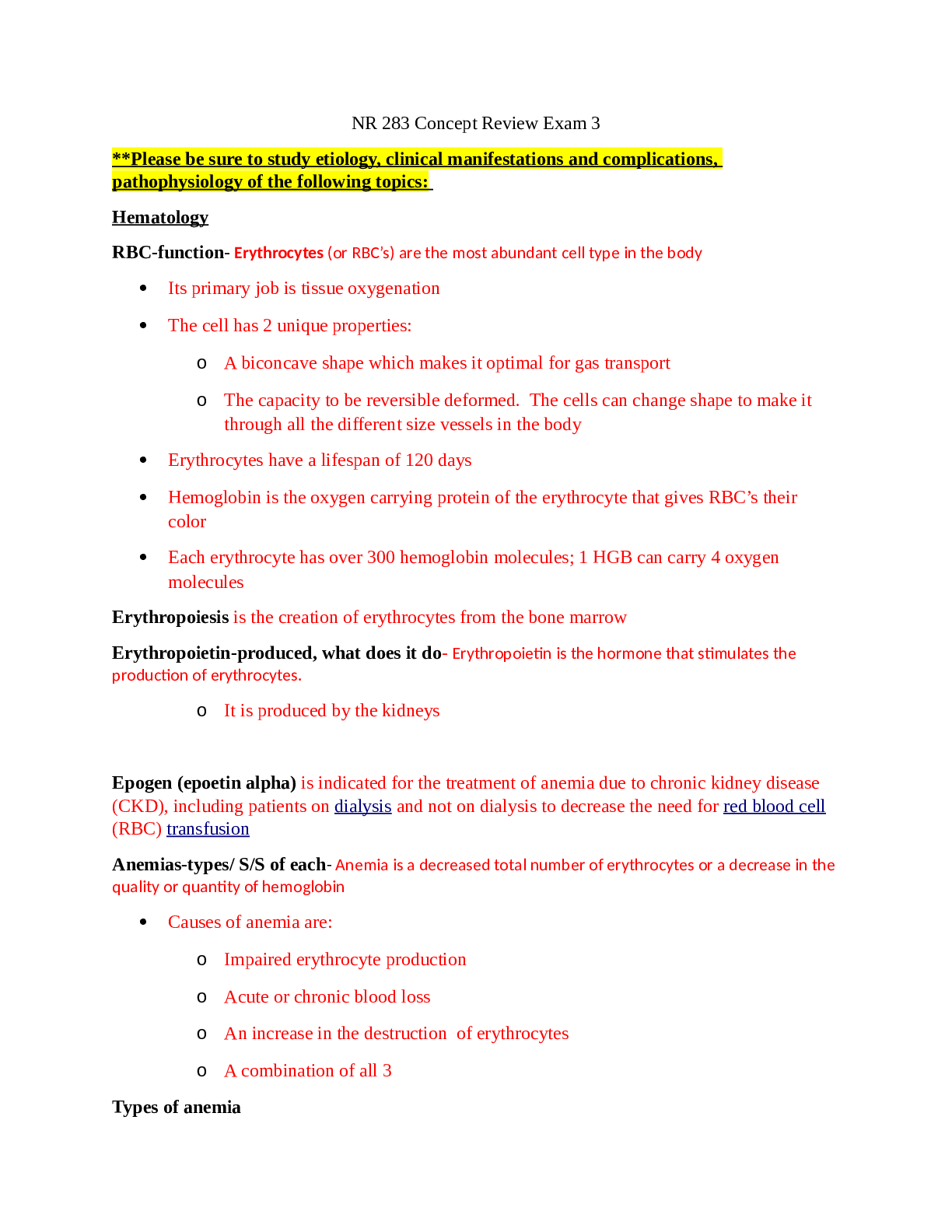
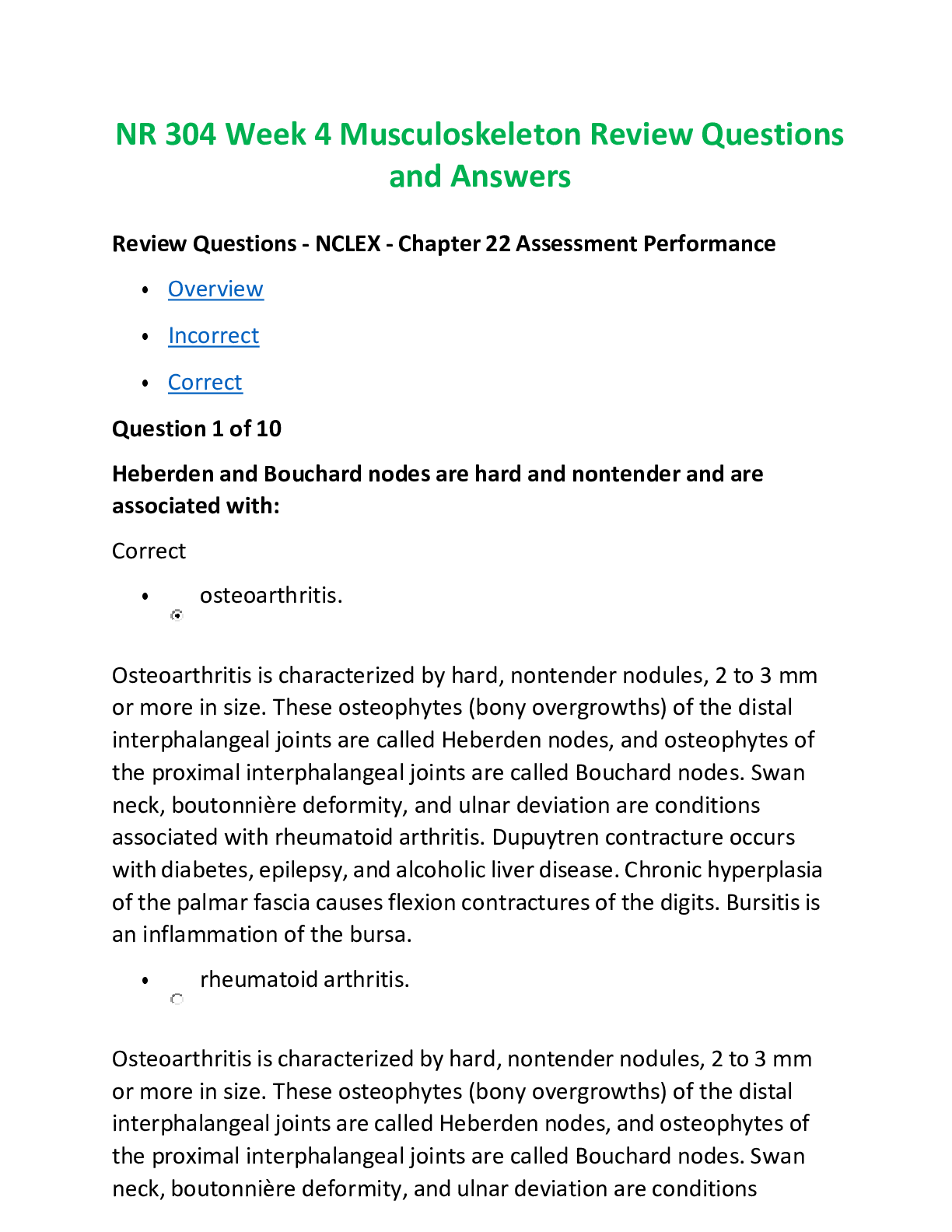

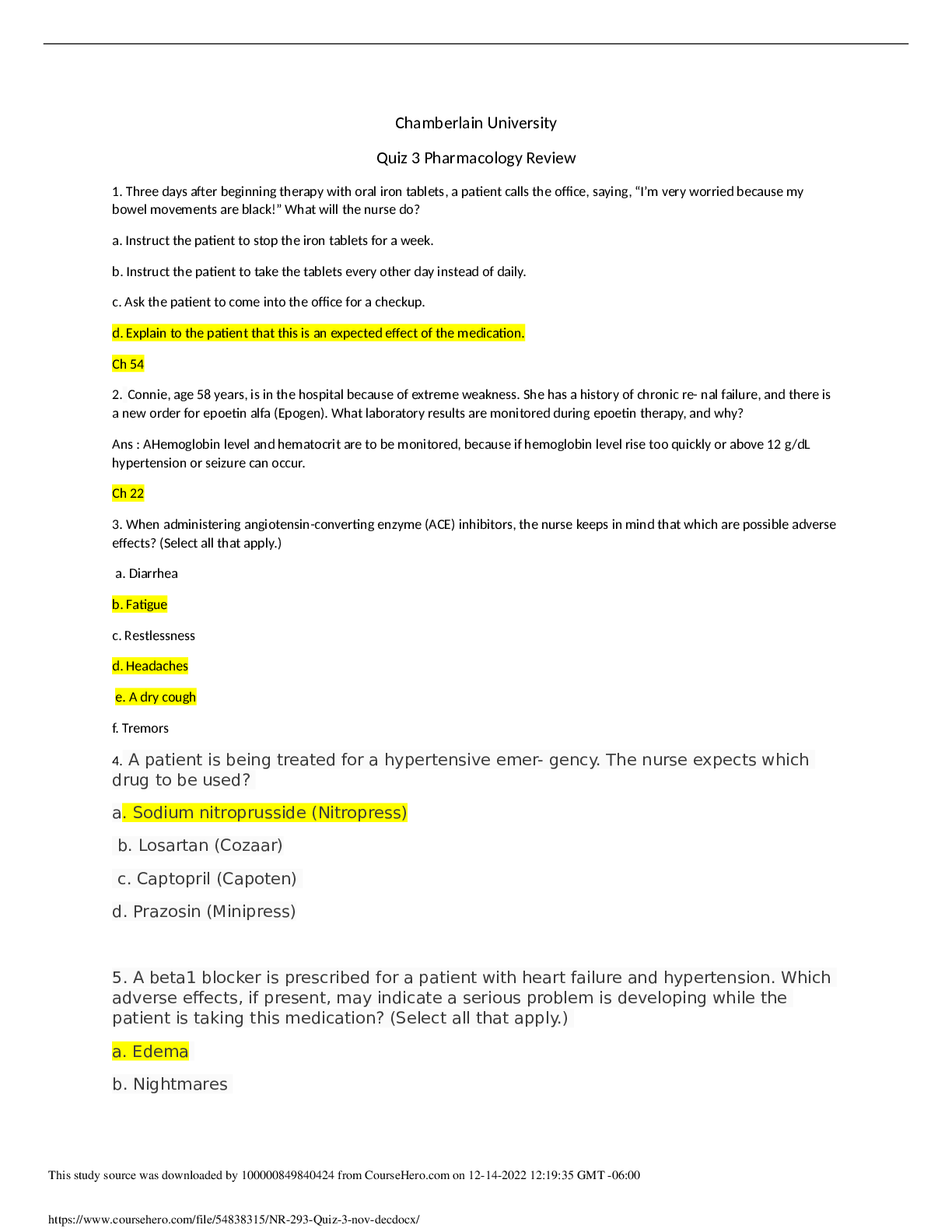

.png)
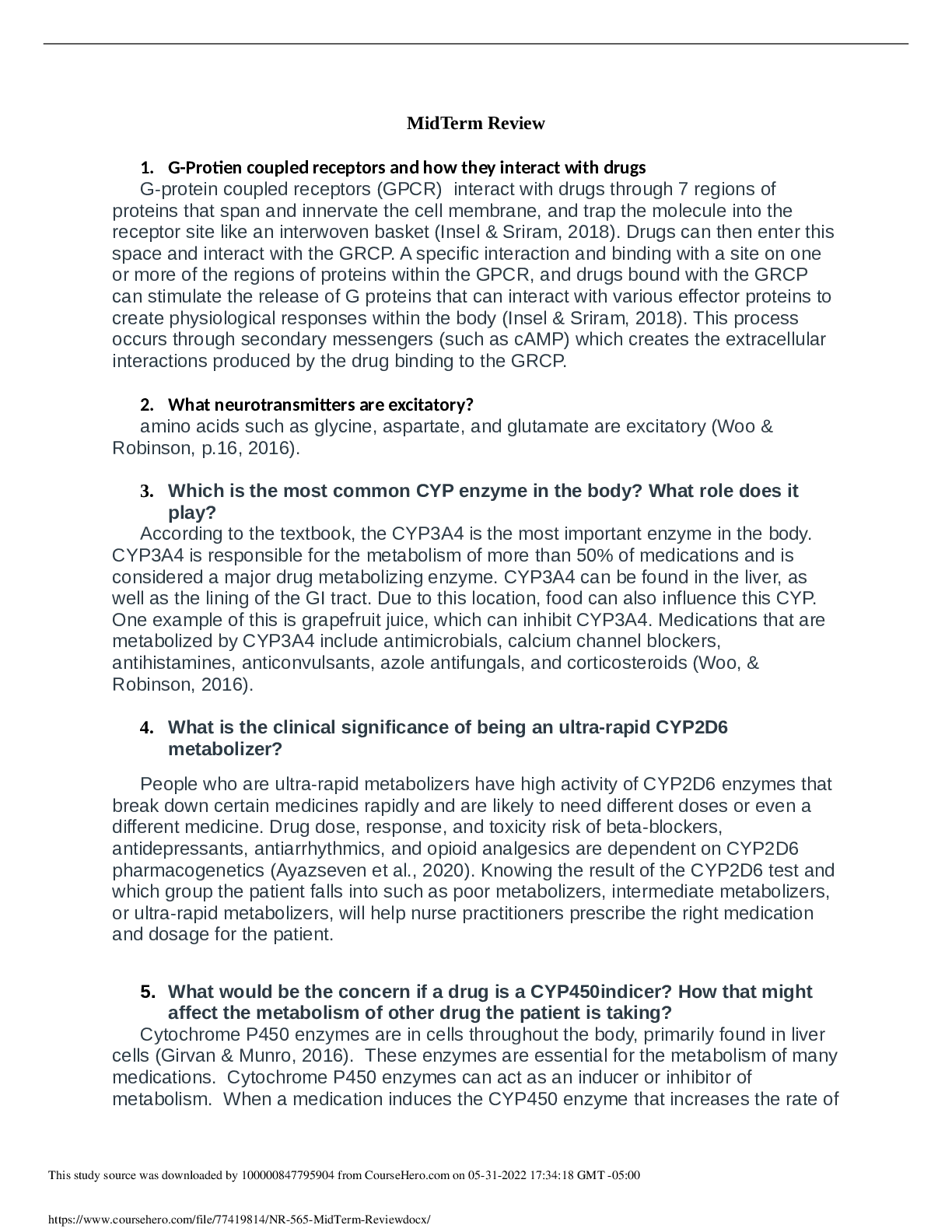
.png)

